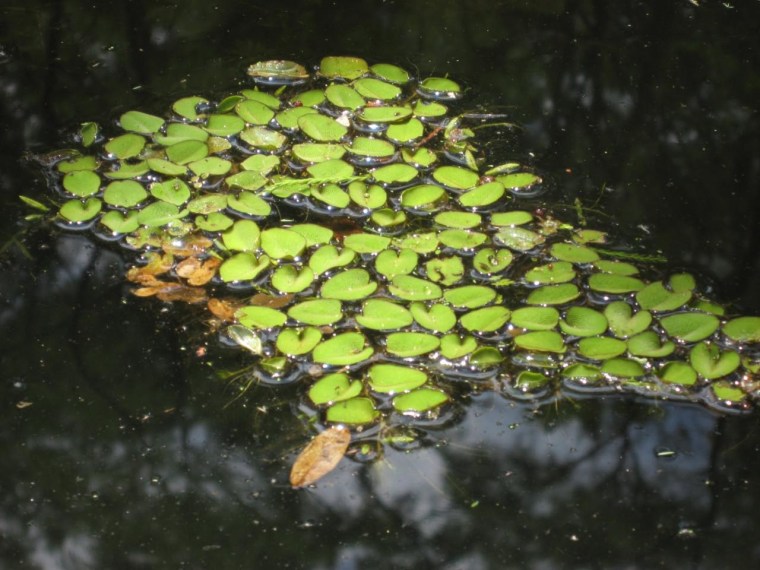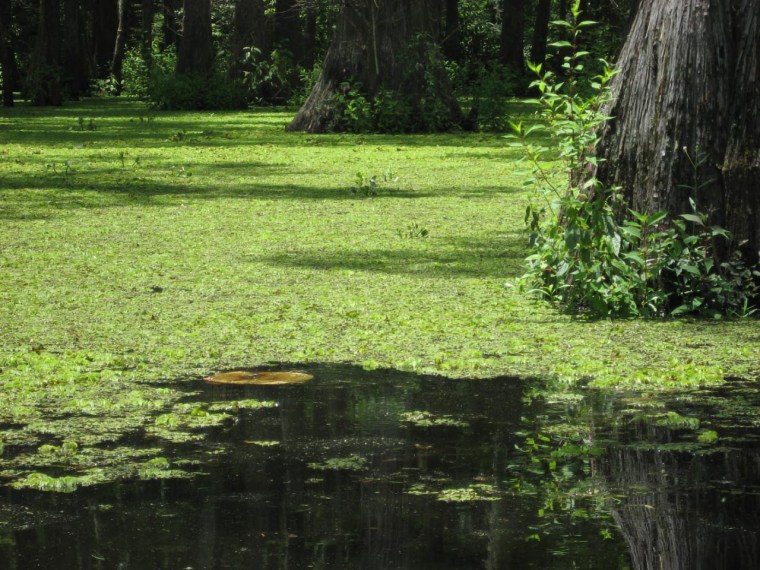At first glance, it looks like a beautiful addition to the water: a floating fern with small, bright green leaves.
But when Robert Speight saw just a few sprigs of the plant on Caddo Lake for the first time late last year, his heart sank.
“When I saw it here,” Speight says, “I knew we were in for a long, tough battle.”
The little fern, known as giant salvinia, is like something out of a science fiction movie. Biologists call it the world’s worst weed. The plant has the uncanny ability to reproduce itself rapidly. One plant can become 60 million in less than two months. A handful today will cover more than 40 acres in just a few weeks time.
Left unchecked, the invasive plant forms giant mats on top of a water surface, smothering all life below.
“This is the most sinister aquatic plant I’ve ever dealt with,” says Randy Westbrooks, an invasive species specialist with the U.S. Geological Survey. “It takes no prisoners.”
Giant salvinia is native to the Amazon region of Brazil, where it’s kept in check by natural forces, namely a Brazilian weevil. The invasive plant was first discovered in the U.S. in a pond in South Carolina in 1995. Biologists believe it may have hitched a ride in a shipment of Brazilian lilies. Without a natural enemy, the small fern began spreading exponentially. The plant has been reported in a handful of lakes and streams from the Carolinas to California. Anywhere it ‘s spotted it brings trouble, as some say, like a green creature from the deep.
“You have to take it seriously, just like a disease, and get rid of it as fast as you can,” Westbrooks warns.
Robert Speight maneuvers his small boat through the chocolate-brown water of Caddo Lake, past the cypress trees covered in Spanish moss, until his boat is surrounded by a carpet of green. He turns off the boat motor before it becomes clogged by the giant salvinia floating on the water. “This is the mature plant,” he says as he leans over, sticking his hand through the green layer to scoop up a handful. “It’s starting to fold on itself and get to the clumping or matting stage,” he says.
Speight looks out beyond his boat to the lifeless water around him. “It will actually block out the sunlight, block out the oxygen in the water. The fish and animals die,” he says. “I’ve been on Caddo Lake all my life; I got my first boat when I was seven. This stuff scares the hell out of me.”
Caddo Lake is the largest naturally-formed lake in Texas and, arguably, one of the most beautiful. It straddles the Texas-Louisiana state line. Giant salvinia has been found on the Louisiana side of the lake, where the water is generally more open. Speight, who is chairman of the Greater Caddo Lake Association, lives on the Texas side, where shallow bayous and sloughs would be the perfect breeding ground for the foreign fern. He and others would like to rid the lake completely of giant salvinia, but short of that, they want to keep it out of the Texas side.
Giant salvinia is already a problem for other Texas lakes.
“It’s the poster child of aquatic weeds,” says Howard Elder, an aquatic biologist with the Texas Parks and Wildlife Department. Toledo Bend and B.A. Steinhagen Reservoirs are among the Texas lakes clogged with salvinia. “It will affect the fish populations and it will affect access to and from the resource,” Elder warns.
Biologists theorize that giant salvinia is spread from lake to lake by boat trailers. As a boat is pulled out of water infested with salvinia, the plant can stick to the sides of a boat or trailer. Elder says all it takes is one leaf to survive the trip to the next lake and a new infestation is started.
“Almost every time we find a new infestation, it’s at a boat ramp,” says Elder, who warns boaters to clean their vessels thoroughly after leaving any salvinia-infested lake.
Such a warning is too late for many lakes across the South. Lake Bistineau is one of eight lakes in northwest Louisiana infested with the noxious weed. When the wind blows from the north, acres of the green matted plant surround marinas, boat docks and vacation homes.
Richard Elliott bought lakefront property on Lake Bistineau with dreams of running a profitable RV park. Then the giant salvinia arrived. “There goes my business,” Elliott said one day last January when he first saw salvinia moving in, completely covering the water surface.
Elliott says he is losing customers because of the invasive weed. “They can’t see the water,” he says. “They don’t even come in and check prices. They just turn around and leave.”
Elliott complained to the Louisiana Department of Wildlife and Fisheries. But the agency seems as helpless as everyone else to stop the spread of giant salvinia. The weed can be controlled with chemical weed killers, but at this late stage on Lake Bistineau and other lakes, that’s a monumental task. Every leaf would have to be sprayed in every corner of the lake or the infestation would start all over again.
“We’re spraying on Bistineau and Caddo as much as possible,” says biologist Jeff Sibley of the Louisiana Department of Wildlife and Fisheries. But the agency has only one boat with a hand chemical sprayer to service eight contaminated lakes in the region.
To keep Caddo Lake from becoming completely infested -- to keep the weed from floating into Texas from Louisiana water -- volunteers on the Texas side of Caddo are taking an unusual approach.

As Ken Shaw’s boat makes its way across Caddo Lake, a thin, bright orange line begins to appear on the water’s horizon. It’s a fence stretching for more than two miles across the middle of Caddo Lake, symbolically not far from the Louisiana state line.
“The only conclusion we came to is we’ve got to put some kind of barricade up,” Shaw says, bringing his boat to a stop near the nylon fence. “What we’re doing here has never been attempted anywhere in the world that we know of.”
The porous fence, which sits just above and below the water, acts as a giant strainer. It catches loose pieces of giant salvinia drifting across the lake from the large patches on the Louisiana side.
“It looks like it’s doing its job,” says Elder, the Texas biologist, who is impressed with the tenacious attitude of Caddo Lake residents.
Heading up the fight against giant salvinia on Caddo is Jack Canson, the lake’s self-proclaimed “weed warden.” He and others with the Giant Salvinia Task Force have raised $35,000 from local organizations and businesses to build and maintain the fence.
“What we’re trying to do on Caddo Lake is draw a line in the sand – like at the Alamo – saying ‘you’re not going past us without a fight.’”
Texas and other states have tried letting a bug do the fighting. A Brazilian weevil that keeps giant salvinia under control in South America was set loose on Toledo Bend Reservoir, where nearly five thousand acres of the weed cover the lake. But biologists say the weevil doesn’t survive well outside the Amazon.
Unfortunately, giant salvinia does.
For now, the best defense against this aquatic monster may be an ugly nylon fence separating two states.
Texas biologist Howard Elder says it beats the alternative. "Sacrifices have to be made,” he says. “It's a lot prettier than looking at a field full of giant salvinia."
